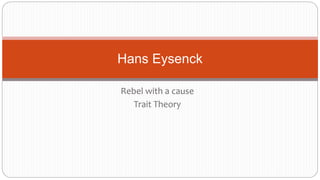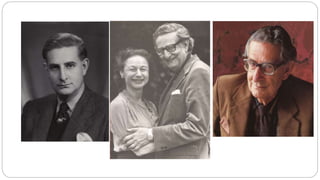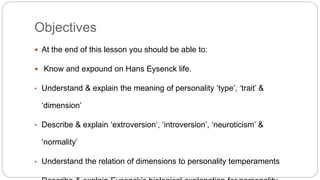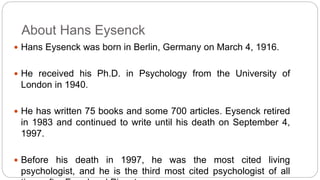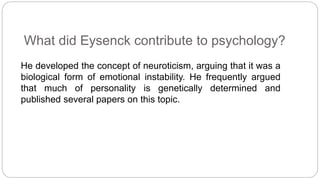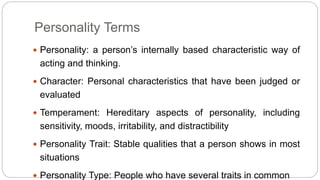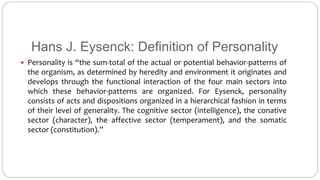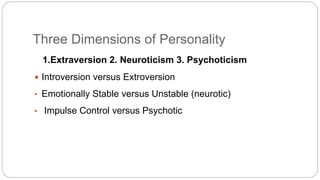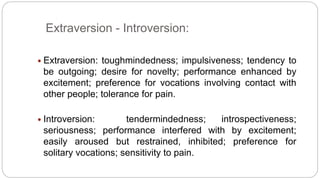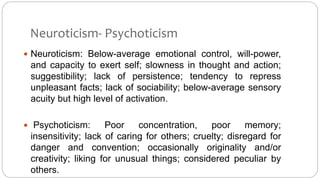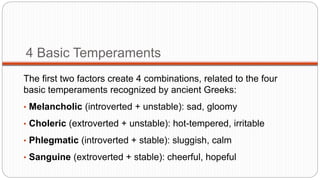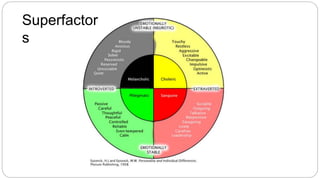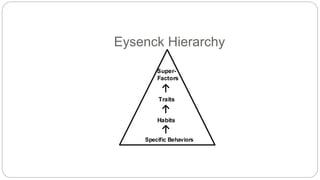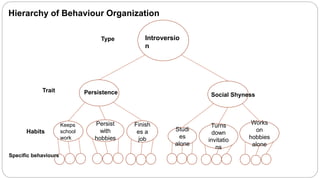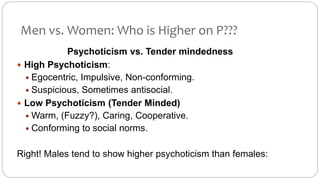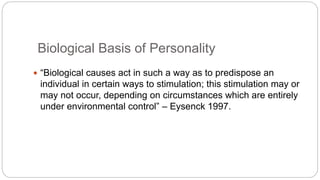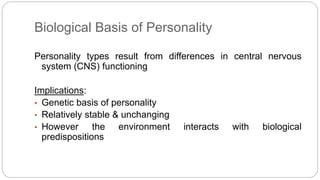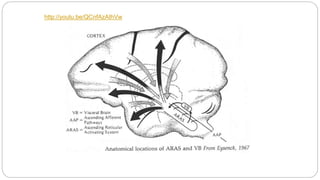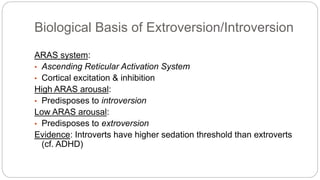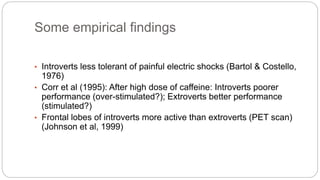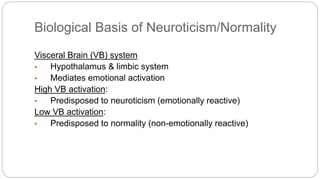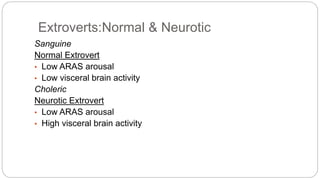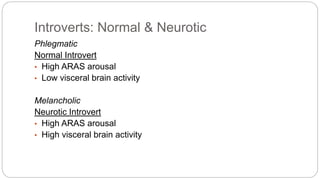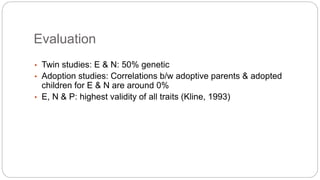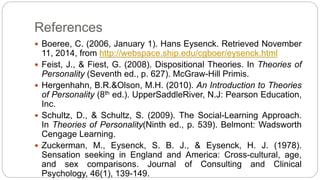Hans Eysenck theory of Personality
- 1. Hans Eysenck Rebel with a cause Trait Theory
- 3. Objectives At the end of this lesson you should be able to: Know and expound on Hans Eysenck life. • Understand & explain the meaning of personality ‘type’, ‘trait’ & ‘dimension’ • Describe & explain ‘extroversion’, ‘introversion’, ‘neuroticism’ & ‘normality’ • Understand the relation of dimensions to personality temperaments • Describe & explain Eysenck’s biological explanation for personality
- 4. About Hans Eysenck Hans Eysenck was born in Berlin, Germany on March 4, 1916. He received his Ph.D. in Psychology from the University of London in 1940. He has written 75 books and some 700 articles. Eysenck retired in 1983 and continued to write until his death on September 4, 1997. Before his death in 1997, he was the most cited living psychologist, and he is the third most cited psychologist of all time, after Freud and Piaget.
- 5. What did Eysenck contribute to psychology? He developed the concept of neuroticism, arguing that it was a biological form of emotional instability. He frequently argued that much of personality is genetically determined and published several papers on this topic.
- 6. Personality Terms Personality: a person’s internally based characteristic way of acting and thinking. Character: Personal characteristics that have been judged or evaluated Temperament: Hereditary aspects of personality, including sensitivity, moods, irritability, and distractibility Personality Trait: Stable qualities that a person shows in most situations Personality Type: People who have several traits in common
- 7. Hans J. Eysenck: Definition of Personality Personality is “the sum-total of the actual or potential behavior-patterns of the organism, as determined by heredity and environment it originates and develops through the functional interaction of the four main sectors into which these behavior-patterns are organized. For Eysenck, personality consists of acts and dispositions organized in a hierarchical fashion in terms of their level of generality. The cognitive sector (intelligence), the conative sector (character), the affective sector (temperament), and the somatic sector (constitution).”
- 8. Three Dimensions of Personality 1.Extraversion 2. Neuroticism 3. Psychoticism Introversion versus Extroversion • Emotionally Stable versus Unstable (neurotic) • Impulse Control versus Psychotic
- 9. Extraversion - Introversion: Extraversion: toughmindedness; impulsiveness; tendency to be outgoing; desire for novelty; performance enhanced by excitement; preference for vocations involving contact with other people; tolerance for pain. Introversion: tendermindedness; introspectiveness; seriousness; performance interfered with by excitement; easily aroused but restrained, inhibited; preference for solitary vocations; sensitivity to pain.
- 10. Neuroticism- Psychoticism Neuroticism: Below-average emotional control, will-power, and capacity to exert self; slowness in thought and action; suggestibility; lack of persistence; tendency to repress unpleasant facts; lack of sociability; below-average sensory acuity but high level of activation. Psychoticism: Poor concentration, poor memory; insensitivity; lack of caring for others; cruelty; disregard for danger and convention; occasionally originality and/or creativity; liking for unusual things; considered peculiar by others.
- 11. 4 Basic Temperaments The first two factors create 4 combinations, related to the four basic temperaments recognized by ancient Greeks: • Melancholic (introverted + unstable): sad, gloomy • Choleric (extroverted + unstable): hot-tempered, irritable • Phlegmatic (introverted + stable): sluggish, calm • Sanguine (extroverted + stable): cheerful, hopeful
- 12. Superfactor s
- 13. Eysenck Hierarchy Super- Factors Traits Habits Specific Behaviors
- 14. Hierarchy of Behaviour Organization Type Persist with hobbies Finish es a job Keeps school work Studi es alone Works on hobbies alone Turns down invitatio ns Introversio n Persistence Social Shyness Trait Habits Specific behaviours
- 16. Activity http://youtu.be/hY5uL0sVxnM https://www.youtube.com/watch?v=S3Qs7cpixd0
- 17. Men vs. Women: Who is Higher on P??? Psychoticism vs. Tender mindedness High Psychoticism: Egocentric, Impulsive, Non-conforming. Suspicious, Sometimes antisocial. Low Psychoticism (Tender Minded) Warm, (Fuzzy?), Caring, Cooperative. Conforming to social norms. Right! Males tend to show higher psychoticism than females:
- 18. Biological Basis of Personality “Biological causes act in such a way as to predispose an individual in certain ways to stimulation; this stimulation may or may not occur, depending on circumstances which are entirely under environmental control” – Eysenck 1997.
- 19. Biological Basis of Personality Personality types result from differences in central nervous system (CNS) functioning Implications: • Genetic basis of personality • Relatively stable & unchanging • However the environment interacts with biological predispositions
- 21. Biological Basis of Extroversion/Introversion ARAS system: • Ascending Reticular Activation System • Cortical excitation & inhibition High ARAS arousal: • Predisposes to introversion Low ARAS arousal: • Predisposes to extroversion Evidence: Introverts have higher sedation threshold than extroverts (cf. ADHD)
- 22. Some empirical findings • Introverts less tolerant of painful electric shocks (Bartol & Costello, 1976) • Corr et al (1995): After high dose of caffeine: Introverts poorer performance (over-stimulated?); Extroverts better performance (stimulated?) • Frontal lobes of introverts more active than extroverts (PET scan) (Johnson et al, 1999)
- 23. Biological Basis of Neuroticism/Normality Visceral Brain (VB) system • Hypothalamus & limbic system • Mediates emotional activation High VB activation: • Predisposed to neuroticism (emotionally reactive) Low VB activation: • Predisposed to normality (non-emotionally reactive)
- 24. Extroverts:Normal & Neurotic Sanguine Normal Extrovert • Low ARAS arousal • Low visceral brain activity Choleric Neurotic Extrovert • Low ARAS arousal • High visceral brain activity
- 25. Introverts: Normal & Neurotic Phlegmatic Normal Introvert • High ARAS arousal • Low visceral brain activity Melancholic Neurotic Introvert • High ARAS arousal • High visceral brain activity
- 26. Evaluation • Twin studies: E & N: 50% genetic • Adoption studies: Correlations b/w adoptive parents & adopted children for E & N are around 0% • E, N & P: highest validity of all traits (Kline, 1993)
- 28. References Boeree, C. (2006, January 1). Hans Eysenck. Retrieved November 11, 2014, from http://webspace.ship.edu/cgboer/eysenck.html Feist, J., & Fiest, G. (2008). Dispositional Theories. In Theories of Personality (Seventh ed., p. 627). McGraw-Hill Primis. Hergenhahn, B.R.&Olson, M.H. (2010). An Introduction to Theories of Personality (8th ed.). UpperSaddleRiver, N.J: Pearson Education, Inc. Schultz, D., & Schultz, S. (2009). The Social-Learning Approach. In Theories of Personality(Ninth ed., p. 539). Belmont: Wadsworth Cengage Learning. Zuckerman, M., Eysenck, S. B. J., & Eysenck, H. J. (1978). Sensation seeking in England and America: Cross-cultural, age, and sex comparisons. Journal of Consulting and Clinical Psychology, 46(1), 139-149.

